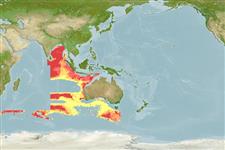>
Trachichthyiformes (Roughies) >
Trachichthyidae (Slimeheads)
Etymology: Hoplostethus: Greek, hoplon = weapon + Greek, stetho, stethion = brest; literal = to prick a little breast (Ref. 45335).
Eponymy: Dar Alexeevich Shubnikov worked at the All-Russian Research Institute of Fisheries and Oceanography (VNIRO). [...] (Ref. 128868), visit book page.
Environment: milieu / climate zone / depth range / distribution range
Ecologia
marino batipelagico; distribuzione batimetrica 800 - 875 m (Ref. 9872). Deep-water
Indian Ocean: northern section of the Mentawai ridge. Also reported from Western Australia (Ref. 7300).
Size / Peso / Age
Maturity: Lm ? range ? - ? cm
Max length : 20.3 cm SL maschio/sesso non determinato; (Ref. 9872)
Found on the continental slope (Ref. 75154).
Life cycle and mating behavior
Maturità | Riproduzione | Deposizione | Uova | Fecundity | Larve
Kotlyar, A.N., 1980. Systematic and distribution of trachichthyid fishes (Trachichthyidae, Beryciformes) of the Indian ocean. Trudy Inst. Okeanol. 110:177-224. (Ref. 9872)
IUCN Red List Status (Ref. 130435: Version 2024-1)
Threat to humans
Harmless
Human uses
Strumenti
Special reports
Download XML
Fonti Internet
Estimates based on models
Preferred temperature (Ref.
123201): 2 - 6.4, mean 5.2 °C (based on 12 cells).
Phylogenetic diversity index (Ref.
82804): PD
50 = 0.5000 [Uniqueness, from 0.5 = low to 2.0 = high].
Bayesian length-weight: a=0.01660 (0.00714 - 0.03859), b=3.05 (2.85 - 3.25), in cm total length, based on LWR estimates for this (Sub)family-body shape (Ref.
93245).
Trophic level (Ref.
69278): 3.5 ±0.5 se; based on size and trophs of closest relatives
Resilienza (Ref.
120179): Molto basso, tempo minimo di raddoppiamento della popolazione più di 14 anni (Preliminary K or Fecundity.).
Fishing Vulnerability (Ref.
59153): Low vulnerability (15 of 100).
